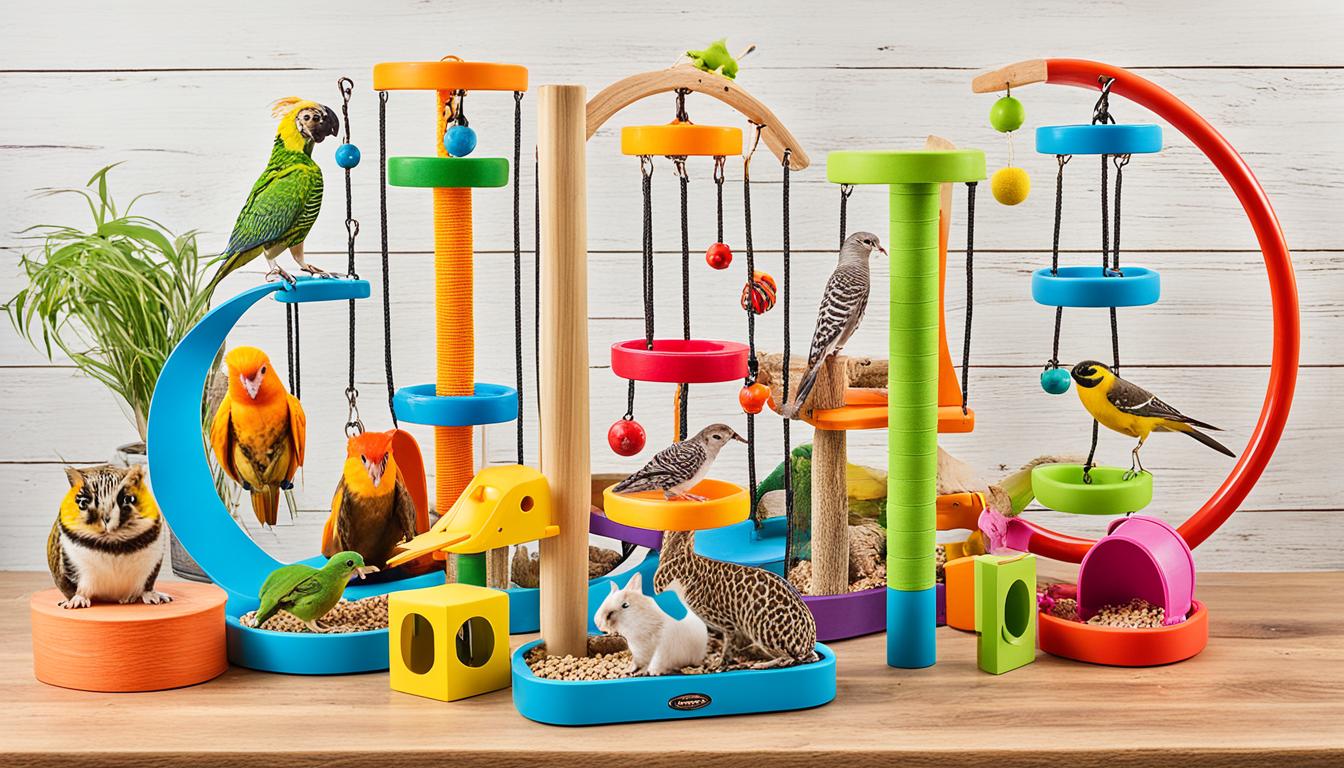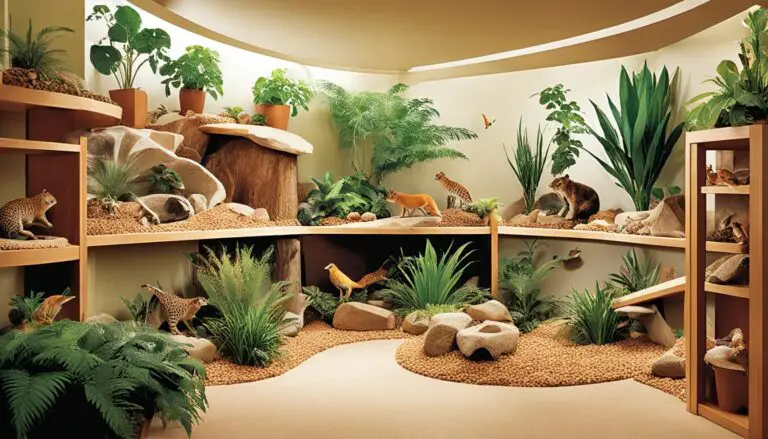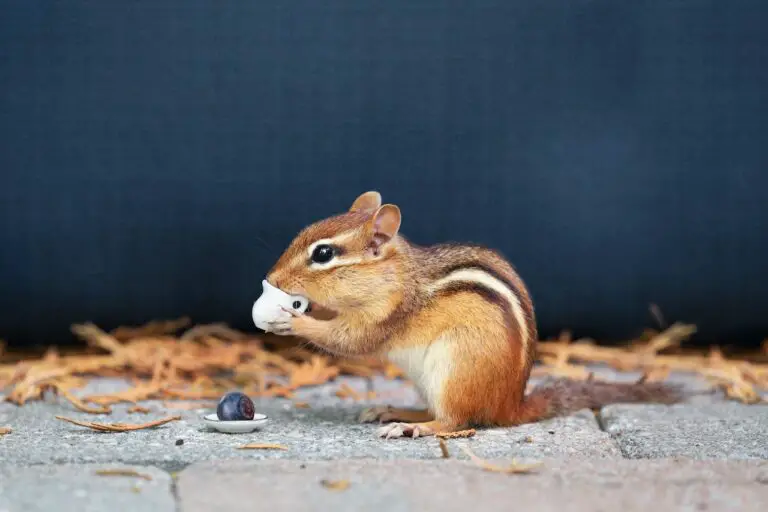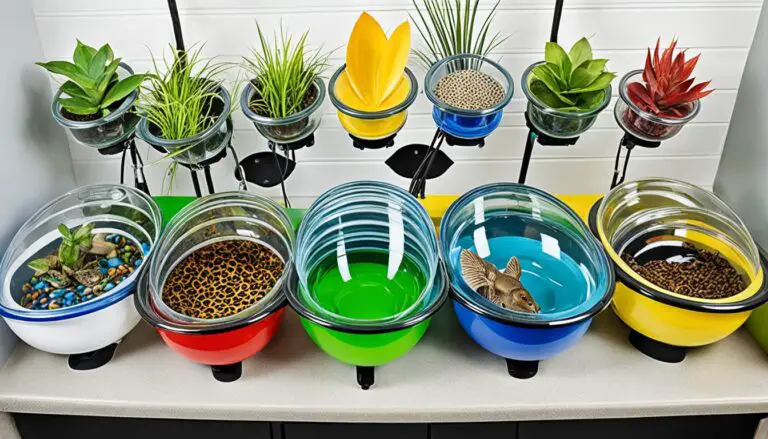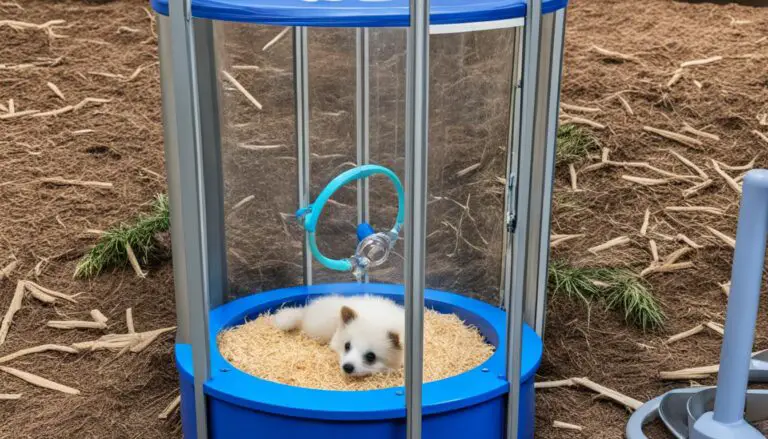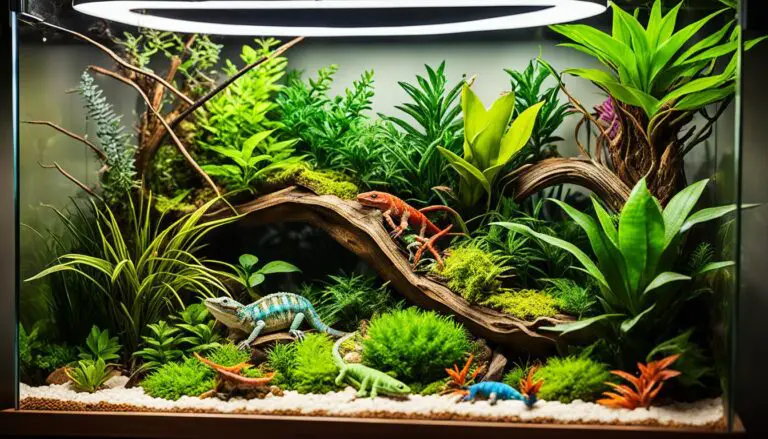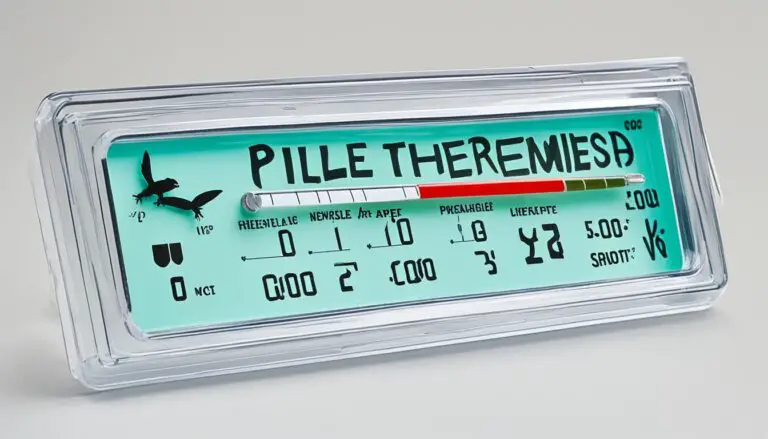Exotic Pet Housing Toys: How to Choose the Right One
Did you know choosing the right housing toys for your exotic pet is crucial? These pets need a space that feels like their natural habitat. By picking the correct enclosure, lights, temperature, and fun toys, you make sure your pet is not just alive, but truly living.
Key Takeaways:
- Research your pet’s natural habitat to understand their specific needs and replicate those conditions in their enclosure.
- Choose the right enclosure size, material, and design to provide enough room for your pet to move and engage in natural behaviors.
- Invest in high-quality lighting and heating equipment to create a comfortable and appropriate environment.
- Use appropriate substrates to maintain a comfortable surface and facilitate natural behaviors like burrowing.
- Offer a variety of enrichment toys and structures that encourage natural behaviors and mental stimulation.
Research Your Pet’s Natural Habitat
Before you pick toys and a house for your exotic pet, learn about where they come from. It’s vital because different pets need different things to feel at home. Think about the weather, warmth, moisture, and plants from their original home when setting up their space.
Knowing where your pet naturally lives helps understand what they need. If your pet is from a place with lots of rain and warmth, they’ll need a humid and warm home. Pets from dry places like deserts will need less moisture and more warmth.
The right temperature is key to keeping your exotic pet happy. Some pets love the heat, while others prefer things cooler. Make sure their new home feels just like their old one, temperature-wise, to keep them healthy.
Plants are more than just decoration in your pet’s home; they’re essential. They give your pet food, a place to hide, and make their space more interesting. Include plants from their native area to make them feel safe and at home.
Making a home that feels like their natural habitat is vital for your pet’s health and happiness. By matching the climate, warmth, moisture, and plants of their original home, you make a comfy and exciting space for them.
Examples of Exotic Pets and Their Natural Habitats
| Exotic Pet | Natural Habitat |
|---|---|
| Bearded Dragon | Arid and semi-arid regions of Australia |
| Red-Eyed Tree Frog | Tropical rainforests of Central and South America |
| Leopard Gecko | Desert regions of Afghanistan, India, and Pakistan |
| Brazilian Rainbow Boa | Tropical rainforests and wetlands of Brazil |
Choose the Right Enclosure
Choosing the right enclosure is a must for your exotic pet’s well-being. The perfect enclosure depends on size, material, and design. These factors make sure your pet is happy and healthy.
The size of the enclosure is critical. It must match your pet’s needs. Some pets need lots of space to move, climb, or play. Vertical space is great for climbers. Horizontal space suits those who run and play.
Material matters too. It should be strong, easy to clean, and safe. Avoid materials that can hurt your pet or make them sick. Find out what’s best for your pet’s species.
Design
Design is key as well. Some pets need homes like their natural habitat. Others do well with extra features like hiding spots.
Research what your pet needs. They might need perches, branches, or caves. A good design lets them act naturally, making them feel safe and active.
Finding the right enclosure is vital for your pet’s health and happiness. It makes their living space safe and fun, like their natural home. Think about the size, material, and design. This way, your pet can be their best self.
Choosing a suitable enclosure is crucial in caring for your exotic pet. Now, let’s discuss the role of proper lighting and temperature.
Provide Proper Lighting and Temperature
Lighting and temperature matter a lot for keeping your exotic pet healthy and comfy. Good lighting gives your pet UVB rays. These rays help with calcium use and overall health. It’s also key to have the right temperature in your pet’s home for health and digestion.
To mimic the sun, getting good exotic pet lighting is key. LED lights work great for reptiles, giving them the UVB rays they need for bone health. Place lights well so the whole home gets light.
“Proper lighting and temperature are essential for the health and well-being of your exotic pet. UVB lighting is crucial for reptiles to metabolize calcium, while maintaining the appropriate temperature gradient supports digestion and overall health.”
It’s important to have different temperature zones in your pet’s home. This way, they can warm up or cool down as needed, like in the wild.
For warmth, consider heat lamps or ceramic heaters. Use thermostats for accurate temperature control. Always keep an eye on temperatures to keep your pet comfy.
Temperature Guidelines for Common Exotic Pets:
| Species | Daytime Temperature | Nighttime Temperature |
|---|---|---|
| Bearded Dragon | 95-105°F (35-40°C) | 75-80°F (24-27°C) |
| Leopard Gecko | 88-92°F (31-33°C) | 70-75°F (21-24°C) |
| Crested Gecko | 72-78°F (22-26°C) | 65-70°F (18-21°C) |
Getting lighting and temperature right is key for your exotic pet’s happiness. Always check and fix settings to meet your pet’s needs. This way, you help your pet stay healthy and happy.
Mimic Natural Substrates
When setting up a home for your exotic pet, aim to match their wild habitat as best as you can. This means choosing the right substrates for comfort and the right humidity. These elements replicate their natural surroundings closely.
Substrates aren’t just for show. They provide a natural floor for your pet, just like they’d find in the wild. Apart from comfort, substrates help control the humidity, crucial for some pets. By selecting the right ones, you create a great home that supports their health.
If your pet loves to dig, choosing the right substrate is key. This digging is normal for lots of exotic pets. The right substrate lets them burrow, which makes them happy. You should look up what’s best for your pet’s specific needs.
It’s vital to keep your pet’s home clean and change the substrates regularly. This stops waste and germs from building up. A clean home keeps your pet healthy and happy.
By picking and looking after the right substrates, you make a home that feels like their natural world. This gives them a cozy and stimulating place to live.

| Substrate Options | Advantages | Disadvantages |
|---|---|---|
| Sand | Allows for burrowing behavior Regulates humidity levels |
Can be difficult to maintain cleanliness Ingestion can lead to impaction in some species |
| Coconut Fiber | Natural and eco-friendly Retains moisture well |
May harbor pests if not properly maintained Needs regular replacement to prevent mold growth |
| Bark | Natural appearance Provides hiding places for pets |
Can be messy and difficult to clean Some species may chew on the bark |
Offer Hiding Places and Enrichment
Enrichment is key for your exotic pet’s care. They need different ways to stay busy and avoid getting bored. This means giving them toys, places to climb, and spots to hide. These should suit their need to explore and act naturally.
Exotic pet enrichment toys aim to be like what pets find in the wild. They boost their senses and keep them both mentally and physically fit. Climbing gadgets let them exercise and climb like they would naturally. Hiding spots offer them a safe place to go when they need peace or feel stressed.
Pets have various interests in toys. Some might like puzzles that test their thinking, while others might prefer ones that let them hunt or forage. Interactive toys are great for keeping your pet involved and mentally sharp. Watching what your pet likes helps you pick the most fun and engaging toys for them.
Promoting Natural Behaviors
Choosing the right toys and enrichment is crucial. Pets need to act out their natural instincts and behaviors, even in captivity. For example, reptiles might like toys for basking or climbing. In contrast, small mammals might enjoy things that let them dig or nest.
“Toys that encourage natural habits are vital for your exotic pet’s happiness. They prevent boredom and health problems by keeping them active.”
Think about adding climbing setups in your pet’s space. These could range from simple branches to special designs. They’re great for both exercise and exploration. They even help pets make the most of vertical space, which some species really need.
Having different enrichment activities makes every day interesting for your pet. It stops them from getting used to the same old toys. Change up their toys and hiding spots often to keep things fresh and exciting.
By offering various hiding and play options, you craft a fun habitat for your exotic pet. This supports their health and happiness. Plus, it lets them act out their natural instincts, ensuring they enjoy their life with you.
Maintain a Clean and Healthy Habitat
Keeping your exotic pet’s home clean is key to their health. Setting up a cleaning routine helps keep their space hygienic. Cleaning gets rid of dirt and smells while stopping harmful bacteria from growing.
Begin by taking away any food not eaten right away. This stops bacteria from growing. Then, toss out waste and clean the space well, focusing on every surface and corner. Use safe disinfectants and follow the directions closely. Make sure to rinse out any leftover chemicals.
Cleaning the habitat regularly makes it healthier for your pet. Waste buildup can cause health issues, like breathing problems or infections. Cleanliness gives your pet a comfortable life and a long one too.
Importance of Waste Removal
Removing waste properly keeps your pet’s home clean and healthy. Waste can smell bad, bring pests, and grow harmful bacteria. Getting rid of waste often cuts down disease risks in their home.
Waste should be removed daily to keep the area clean. Throw away solid waste quickly and swap out dirty bedding. For pee or poop, clean well with the right cleaners to stop bacteria.
“Regular maintenance is key to providing a clean and hygienic environment for your exotic pet. By establishing a routine for cleaning and waste removal, you can ensure their well-being and prevent the onset of health issues.”
Disinfecting for a Healthier Habitat
Disinfecting your pet’s home often is crucial. It kills bacteria or germs that could make them sick. It keeps their space clean and cuts down on illness risks.
Pick a disinfectant made for exotic pet homes and use it as directed. Make sure it’s safe for your pet and leaves no harmful residue. Clean frequently touched areas carefully to avoid bacteria.
Regularly disinfecting, along with cleaning, keeps your pet’s home safe. It lowers the chance of infections, helping your pet stay happy and healthy.
Food Removal: Avoiding Foul Odors and Contamination
It’s important to take out any uneaten food from your pet’s habitat. Leftover food can smell and attract pests and bacteria. Taking food out right away stops these problems.
Watch how much your pet eats and give them the right amount of food. Remove any food that’s not eaten after they’ve finished. This keeps them safe from health risks and checks if they’re eating well.

It’s important to clean, disinfect, remove waste, and take out uneaten food regularly. This keeps your pet’s habitat clean and them healthy. A well-kept home makes your pet happy and helps them live longer.
Conclusion
Creating a great home for your exotic pet takes time, research, and effort. You need the right cage, light, temperature, ground cover, fun activities, and a clean space. This makes sure your pet has the best place to live.
Think about what your pet specifically needs. Offer toys and structures that let them act like they would in the wild. Exotic pets do best when they have different toys. These playthings should make them think and keep them busy.
When you make their living area like their natural home, your pet can really do well. They’ll be happy and live a good life.
Choosing the right home and giving lots of things to think about is key. It makes their life better and brings you closer to them. Learn about their wild habits and create a space that meets those needs. With fun toys and a smartly set up space, your exotic pet will flourish.
FAQ
What should I consider when choosing housing toys for my exotic pet?
How do I research my exotic pet’s natural habitat?
What factors should I consider when choosing an enclosure for my exotic pet?
How important is lighting and temperature for my exotic pet’s habitat?
What should I consider when selecting substrates for my exotic pet’s enclosure?
Why is enrichment important for my exotic pet?
How can I maintain a clean and healthy habitat for my exotic pet?
How can I create an ideal habitat for my exotic pet?
Source Links
- https://flamingopetclinic.com/guinea-pig-toys/
- https://www.dogwoodvethospital.com/blog-resources/blog/2023/8/24/creating-an-ideal-habitat-for-your-exotic-pet/
- https://www.shilohsvet.com/blog/a-whole-new-world-safe-toys-for-birds-and-exotics/
Peter Stones is the founder of Exotic Pets Place, the leading online resource for exotic pet care information.
With over 10 years of hands-on exotic pet ownership experience, he is deeply passionate about sharing his expertise to help others properly care for their unusual pets.
When he's not writing extensively researched articles or connecting with fellow exotic pet enthusiasts worldwide, you can find Peter at home tending to his own beloved menagerie of exotic animals.

